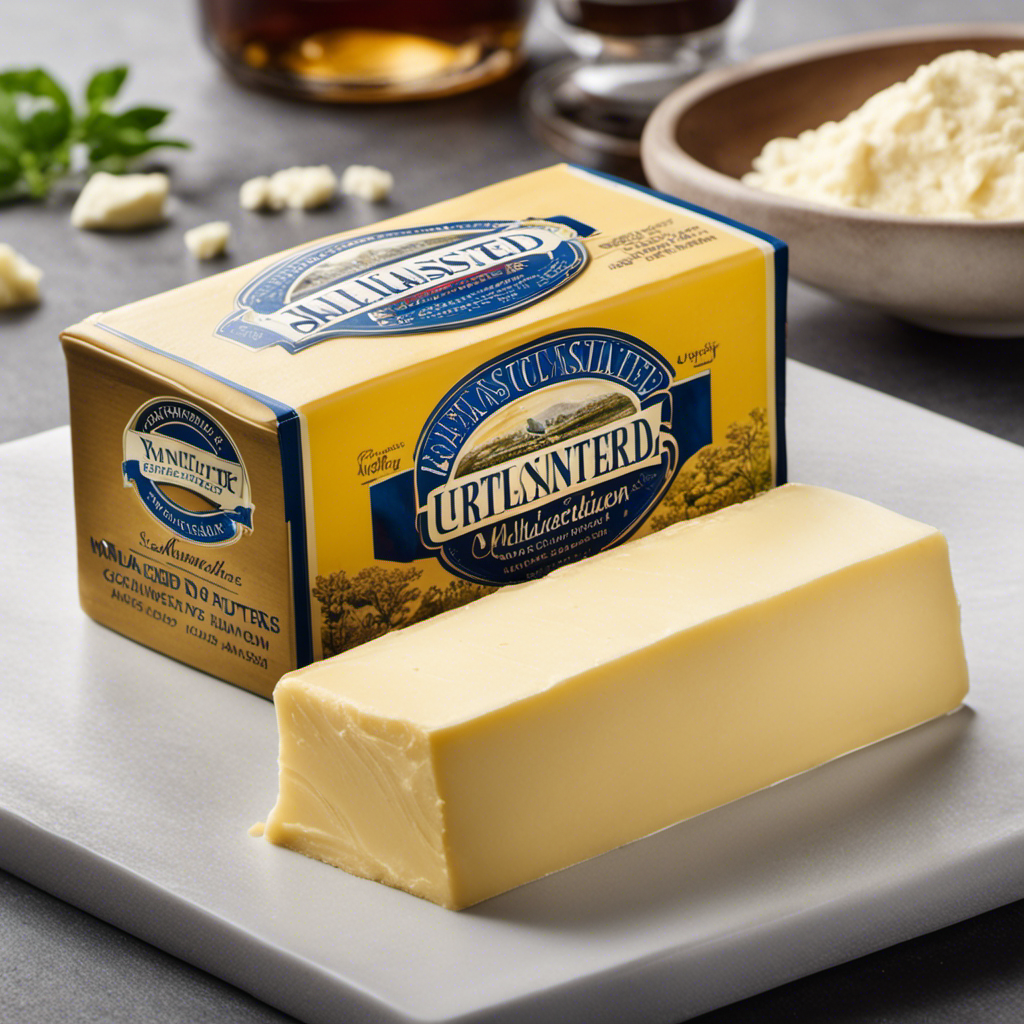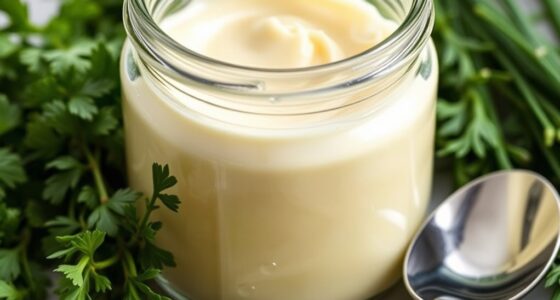I have always been intrigued by the sodium levels in salted butter, particularly because I enjoy using it in my baking. As a result, I delved further to discover the precise amount of salt present in 1/2 cup of this delightful creamy butter.
In this article, we’ll explore the importance of measuring salt in recipes, how salted butter affects our daily sodium intake, and compare the salt content in salted and unsalted butter.
Plus, I’ll share some tips on reducing sodium in your baking with salted butter.
Let’s dive in!
Key Takeaways
- Sodium content in salted butter can vary depending on the brand and manufacturing process.
- 1/2 cup of salted butter typically contains around 1,000 milligrams of sodium, which is about 43% of the recommended daily intake for an average adult.
- Excessive sodium intake can lead to high blood pressure, heart disease, kidney damage, and fluid retention.
- Choosing low sodium options or unsalted butter can help reduce sodium intake.
Understanding the Sodium Content in Salted Butter
Did you know that the sodium content in salted butter can vary depending on the brand?
It’s important to understand the amount of sodium in our food, as excessive sodium intake can pose health risks such as high blood pressure and increased risk of heart disease.
When measuring sodium in salted butter, it’s crucial to check the nutrition label for accurate information. Different brands may have different levels of sodium due to variations in the manufacturing process and added ingredients.
It’s recommended to choose low-sodium options or unsalted butter if you’re concerned about your sodium intake.
The Importance of Measuring Salt in Your Recipes
The measurement of salt in your recipes is vital for achieving the perfect balance of flavors. Salt not only enhances the taste of food, but it also plays a crucial role in baking.
In baking, salt acts as a flavor enhancer, helping to bring out the sweetness and other flavors in your baked goods. It also strengthens the gluten structure in dough, leading to better texture and rise.
However, it is important to use salt in moderation, as excessive sodium intake can have negative health effects. High sodium intake has been linked to increased blood pressure and an increased risk of heart disease. Therefore, it is essential to carefully measure the amount of salt you add to your recipes to ensure a well-balanced dish.
Now, let’s explore how salted butter affects your daily sodium intake.
How Salted Butter Affects Your Daily Sodium Intake
When it comes to our daily sodium intake, it’s important to consider the sodium content in the foods we consume regularly. One such food that often goes unnoticed is salted butter.
Many people use butter in their cooking and baking without realizing that it can contribute to their sodium intake.
In this discussion, we will explore the sodium content of butter, how it can impact our daily sodium intake, and alternatives to salted butter that can help us reduce our sodium consumption.
Butter Sodium Content
You might be surprised by just how much salt is in 1/2 cup of salted butter. While it adds a delicious buttery flavor to dishes, salted butter can also significantly increase your sodium intake.
In a 1/2 cup serving of salted butter, there is typically around 1,000 milligrams of sodium. This is about 43% of the recommended daily sodium intake for an average adult.
If you are watching your sodium intake or have high blood pressure, there are low sodium options available. These options often have little to no added salt, but still provide that rich butter flavoring.
It’s always a good idea to check the labels and compare sodium content when choosing a butter product.
Sodium Intake Impact
In a 1/2 cup serving of salted butter, there’s typically around 1,000 milligrams of sodium, which can significantly impact your sodium intake. It’s important to be mindful of your sodium intake, as excessive consumption can lead to various health risks.
Here are some key points to consider:
-
High blood pressure: Consuming too much sodium can cause an increase in blood pressure, putting a strain on your cardiovascular system.
-
Kidney problems: Excessive sodium intake can contribute to kidney damage and impair their ability to remove waste products from the body.
-
Fluid retention: Sodium has the ability to retain water in the body, leading to bloating and swelling.
-
Increased risk of stroke: High sodium intake has been linked to an increased risk of stroke, which can have serious consequences for your health.
To maintain a healthy lifestyle, it’s essential to follow sodium intake guidelines and be mindful of the health risks associated with consuming too much sodium.
Alternatives to Salted Butter
Consider using alternatives to salted butter, such as olive oil or avocado spread, to reduce your sodium intake. When it comes to reducing salt content in our diet, it’s important to look for healthier options.
Salted butter contains a significant amount of sodium, which can contribute to high blood pressure and other health issues. By choosing butter substitutes like olive oil or avocado spread, you can still enjoy the creamy texture and rich flavor without the added sodium.
Olive oil is a heart-healthy option that is low in sodium and high in monounsaturated fats. Avocado spread is another great choice, packed with healthy fats and a creamy texture.
Experiment with different alternatives to find the best fit for your taste buds and health goals.
Comparing the Salt Content in Salted and Unsalted Butter
When it comes to choosing between salted and unsalted butter, one key consideration is the difference in sodium content. Salted butter contains added salt, which can significantly contribute to your daily sodium intake.
This is important to consider, as excessive sodium consumption has been linked to various health implications, such as high blood pressure and increased risk of heart disease.
Salted Vs Unsalted
Did you know that salted butter contains more salt than unsalted butter? It may seem obvious, but many people don’t realize just how much sodium is in their food. Here are four reasons why understanding sodium levels and choosing unsalted butter can be beneficial for your health:
-
Lowering Blood Pressure: High sodium intake has been linked to hypertension, a major risk factor for heart disease. By choosing unsalted butter, you can reduce your sodium intake and help lower your blood pressure.
-
Kidney Health: Excess sodium can put a strain on your kidneys, potentially leading to kidney damage over time. Opting for unsalted butter can help protect your kidney health.
-
Flavor Control: Unsalted butter allows you to have more control over the flavor of your dishes. You can add salt to taste, without worrying about the excessive sodium content in salted butter.
-
Versatility: Unsalted butter is more versatile in recipes. It can be used in both sweet and savory dishes, allowing you to explore a wider range of culinary options.
Sodium in Butter
Opting for unsalted butter can help reduce your sodium intake and promote better health. Understanding sodium intake is important because excessive consumption of sodium can have detrimental effects on your health.
High sodium intake has been linked to an increased risk of high blood pressure, heart disease, stroke, and kidney problems. It is recommended that adults consume no more than 2,300 milligrams of sodium per day, which is equivalent to about one teaspoon of salt.
By choosing unsalted butter, you have more control over your sodium intake, as salted butter can contain up to 90 milligrams of sodium per tablespoon. This small change can have a big impact on your overall health.
Health Implications of Salt?
If you consume too much sodium, it can negatively impact your health in various ways. Exceeding the recommended daily intake of sodium can increase your risk of developing health problems such as high blood pressure, heart disease, stroke, and kidney disease.
Here are four reasons why you should be mindful of your sodium intake:
-
High blood pressure: Consuming too much sodium can raise your blood pressure, putting strain on your heart and increasing the risk of cardiovascular disease.
-
Increased stroke risk: High sodium intake has been associated with an increased risk of stroke, which can have severe consequences for your health and well-being.
-
Kidney damage: Excessive sodium can harm your kidneys, impairing their ability to filter waste and maintain fluid balance in the body.
-
Fluid retention: Consuming too much sodium can lead to water retention, causing bloating and discomfort.
Considering these health risks, it is important to be mindful of your sodium intake and make informed choices about the food you consume.
Transitioning into the subsequent section about reducing sodium in baking with salted butter, let’s explore some tips on how to achieve this.
Tips on Reducing Sodium in Your Baking With Salted Butter
To reduce sodium in your baking with salted butter, try using unsalted butter instead. Salted butter contains added salt, which can contribute to your overall sodium intake. By using unsalted butter, you have more control over the amount of sodium in your recipe.
You can still achieve the desired flavor by adding salt to your baked goods separately, allowing you to reduce the overall sodium content. This simple substitution can be an effective way to reduce your sodium intake while still enjoying your favorite baked treats.
However, if you’re looking for even lower sodium options, there are alternatives to salted butter available that can provide a similar taste and texture without the added sodium. Let’s explore these alternatives in the next section.
Exploring Alternatives to Salted Butter for a Lower Sodium Option
Looking for a lower sodium option? Consider trying out alternative options to salted butter for your baking needs. Here are four alternatives to consider, each with its own unique qualities and health implications:
-
Olive oil: Not only is olive oil lower in sodium than salted butter, but it also contains heart-healthy monounsaturated fats. It adds a rich flavor and moist texture to baked goods.
-
Applesauce: This natural sweetener can replace salted butter in recipes, reducing the sodium content significantly. It also adds moisture and a subtle fruity taste.
-
Greek yogurt: With its creamy texture and tangy flavor, Greek yogurt can be a great substitute for salted butter. It provides protein and probiotics, making it a healthier option.
-
Avocado: Mashed avocado can replace salted butter in recipes, providing a creamy texture and heart-healthy monounsaturated fats. It adds a unique taste and pairs well with chocolate desserts.
Frequently Asked Questions
Can I Use Unsalted Butter Instead of Salted Butter in My Recipe?
Using unsalted butter in your recipe will result in a milder flavor as compared to using salted butter. However, it won’t significantly affect the texture or outcome of your baked goods.
How Much Sodium Is in Unsalted Butter?
The sodium content in unsalted butter is typically lower than in salted butter. However, it’s important to note that salted margarine and salted cream cheese may have different sodium levels.
What Are Some Alternatives to Salted Butter That Have a Lower Sodium Content?
Low sodium spreads are great alternatives to salted butter in baking. They have a lower sodium content and still provide flavor. I often use them in my recipes to reduce my sodium intake.
How Does the Sodium Content in Salted Butter Compare to Other Common Ingredients Used in Baking?
When comparing the sodium content of salted butter to other baking ingredients, it’s important to consider the impact of sodium on baked goods. Let’s explore how different ingredients vary in sodium content.
Is It Possible to Reduce the Sodium Content in Salted Butter by Rinsing It or Soaking It in Water?
Reducing the sodium content in salted butter by rinsing or soaking it in water is not effective. The amount of salt in 1/2 cup of salted butter is high and cannot be significantly reduced through these methods.
Conclusion
In conclusion, understanding the sodium content in salted butter is crucial for maintaining a balanced diet. By measuring the amount of salt in your recipes, you can control your sodium intake and make healthier choices.
While salted butter adds a savory depth to your dishes, it’s important to be mindful of its impact on your daily sodium intake. Comparing the salt content in salted and unsalted butter can help you make informed decisions.
If you’re looking to reduce sodium, exploring alternatives to salted butter is a great option. Choose wisely, and let your taste buds dance to the rhythm of a healthier you.










